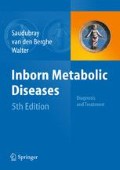Abstract
These disorders cause an unpleasant fish-like body odour. The problems are psychosocial and management centres on attempting to minimise the odour.
Access this chapter
Tax calculation will be finalised at checkout
Purchases are for personal use only
Preview
Unable to display preview. Download preview PDF.
References
Al-Waiz M, Ayesh R, Mitchell SC et al. (1987) A genetic polymorphism of the N-oxidation of trimethylamine in humans. Clin Pharmacol Ther 42:588–594
Mitchell SC, Smith RL (2001) Trimethylaminuria: the fish malodor syndrome. Drug Metab Dispos 29:517–521
Phillips IR, Shephard EA (2007). Trimethylaminuria. In: GeneReviews at GeneTests: Medical Genetics Information Resource (database online). Available at www.genetests.org, last revision March 18 2008
Ziegler DM (1990) Flavin-containing monooxygenases: enzymes adapted for multisubstrate specificity (review). Trends Pharmacol Sci 11: 321–324
Treacy EP, Akerman BR, Chow LML et al. (1998) Mutations of the flavin-containing monooxygenase gene (FMO3) cause trimethylaminuria, a defect in detoxication. Hum Mol Genet 7: 839–845
Cashman JR, Zhang J (2002) Interindividual differences of human flavin-containing monooxygenase 3: genetic polymorphisms and functional variation. Drug Metab Dispos 30: 1043–1052
Kreuger SK, Williams DE (2005) Mammalian flavin-containing monooxygenases: structure/function, genetic polymorphisms and role in drug metabolism. Pharmacol Ther 106:357–387
Shimizu M, Cashman JR, Yamazaki H (2007) Transient trimethylaminuria related to menstruation. BMC Med Genet 8: 2
Koukouritaka SB, Simpson P, Yeung CK et al. (2002) Human hepatic flavin-containing monooxygenase 1 (FMO1) and 3 (FMO3) developmental expression. Pediatr Res 51: 236–243
Ayesh R, Mitchell SC, Zhang A, Smith RL (1993) The fish odour syndrome: biochemical, familial, and clinical aspects. BMJ 307:655–657
Lee CWG, Yu JS, Turner BB, Murray KE (1976) Trimethylaminuria: fishy odours in children. N Engl J Med 295:937–938
Pike MG, King GS, Pettit BR et al. (1988) Lactulose in trimethylaminuria, the fish-odour syndrome. Helv Paediatr Acta 43:345–348
Al-Waiz M, Ayesh R, Mitchell SC et al. (1989) Trimethylaminuria: the detection of carriers using a trimethylamine load test. J Inherit Metab Dis 12:80–85
Shephard EA, Dolphin CT, Fox MF et al. (1993) Localization of genes encoding three distinct flavin-containing monooxygenases to human chromosome1q, Genomics 16:85–89
Yeung CK, Adman ET, Rettie AE (2007) Functional characterization of genetic variants of human FMO3 associated with trimethylaminuria. Arch Biochem Biophys 474:251–259
Zschocke J, Kohlmueller D, Quak E et al. (1999) Mild trimethylaminuria caused by common variants in FMO3 gene. Lancet 354:834–835
Hernandez D, Addou S, Lee D et al. (2003) Trimethylaminuria and a human FMO3 mutation database. Hum Mutat 22:209–213
Fraser-Andrews EA, Manning NJ, Ashton GH et al. (2003) Fish odour syndrome with features of both primary and secondary trimethylaminuria. Clin Exp Dermatol 28:203–205
Chalmers RA, Bain MD, Michelakakis H et al. (2006) Diagnosis and management of trimethylaminuria (FMO3 deficiency) in children. J Inherit Metab Dis 29: 162–172
Busby MG, Fischer L, da Costa KA et al. (2004) Choline-betainedefined diets for use in clinical research and for management of trimethylaminuria. J Am Diet Assoc 104:1836–1845
Yamazaki H, Fujieda M, Togashi M et al. (2004) Effects of the dietary supplements, activated charcoal and copper chlorophyllin, on urinary excretion of trimethylamine in Japanese trimethylaminuria patients. Life Sci 74:2739–2747
Moolenaar SH, Poggi-Bach J, Engelke UFH et al. (1999) Defect in dimethylglycine dehydrogenase, a new inborn error of metabolism: NMR spectroscopy study. Clin Chem 45:459–464
Binzak BA, Vockley JG, Jenkins RB, Vockley J (2000) Structure and analysis of the human dimethylglycine dehydrogenase gene. Mol Genet Metab 69:181–187
Binzak BA, Wevers RA, Moolenaar SH et al. (2001) Cloning of dimethylglycine dehydrogenase and a new human inborn error of metabolism, dimethylglycine dehydrogenase deficiency. Am J Hum Genet 68:839–847
McAndrews RP, Vockley J, Kim JJ (2008) Molecular basis of dimethylglycine dehydrogenase deficiency associated with pathogenic variant H109R. J Inherit Metab Dis 31:761–768
Author information
Authors and Affiliations
Editor information
Editors and Affiliations
Rights and permissions
Copyright information
© 2012 Springer-Verlag Berlin Heidelberg
About this chapter
Cite this chapter
Walker, V., Wevers, R.A. (2012). Trimethylaminuria and Dimethylglycine Dehydrogenase Deficiency. In: Saudubray, JM., van den Berghe, G., Walter, J.H. (eds) Inborn Metabolic Diseases. Springer, Berlin, Heidelberg. https://doi.org/10.1007/978-3-642-15720-2_31
Download citation
DOI: https://doi.org/10.1007/978-3-642-15720-2_31
Publisher Name: Springer, Berlin, Heidelberg
Print ISBN: 978-3-642-15719-6
Online ISBN: 978-3-642-15720-2
eBook Packages: MedicineMedicine (R0)

